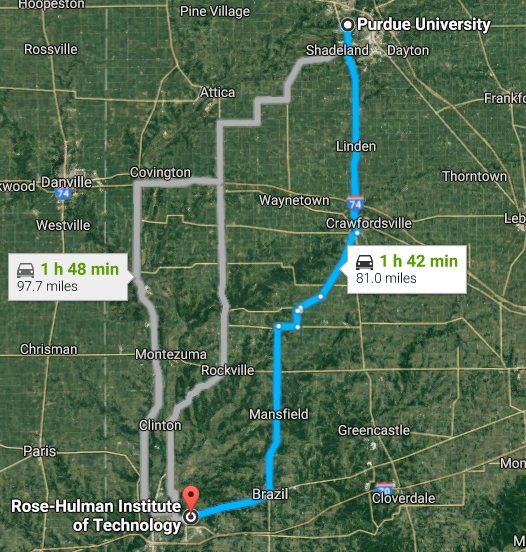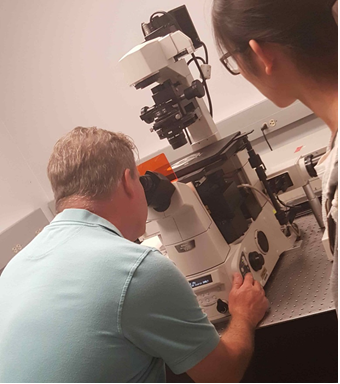| Line 10: | Line 10: | ||
<p class="tab"> | <p class="tab"> | ||
| − | + | Our collaboration efforts have lead the Rose-Hulman Institute of Technology 2016 iGEM team to West Lafayette to visit the Purdue University iGEM team. Our goal of the trip on August 10th, 2016 was to travel to Purdue to make use of their fluorescence microscope. This machinery, which we learned later on in the day go for about 800,000 dollars, was used to capture crystal clear images of our yeast. However, before we could use this awesome machinery we had to first drive the hour and 45 minute trek up to West Lafayette. This meant waking up around 6:00am and drinking various drinks ranging from coffee to energy drinks to get our bodies going in the morning. The drive through the backroads was a peaceful one with music and conversation. Then we hit the college town of West Lafayette. Coming from a relatively small campus, it was a mess trying figure our way through the random one-way streets as we made our way to the parking garage. Our contact, Barrett Davis, was super helpful as he rode his bike to show us exactly where to park. After successfully parking on the third floor, we made our way downstairs to introduce ourselves to Barrett. </p> | |
</html> | </html> | ||
| Line 24: | Line 24: | ||
<p class="tab"> | <p class="tab"> | ||
| − | + | Once acquainted we made our way to the Chemistry and Seed Commissioner building where we were told we would be heading to the basement where the microscope was housed. Once we arrived at the bottom floor we were introduced to Dr. Schaber who was the microscope specialist at Purdue University. Dr. Schaber explained to us the basics of the hardware and software he was using then it was time to get to work. After using a very old and crude fluorescence microscope here at Rose-Hulman Institute of Technology, it was a shock to see the clarity of the pictures and the ease at which they were captured. After a couple hours and focusing on the cluster of cells we wanted, we felt confident that we had enough of our cells pictured for our results. </p> | |
| + | |||
| − | |||
| − | |||
</html> | </html> | ||
| Line 41: | Line 40: | ||
<p class="tab"> | <p class="tab"> | ||
| − | + | After the wonderful results of our pictures we were all extremely hungry and decided we should walk around campus to try and find something to eat. Luckily for us, Purdue University is a very large campus that offers a wide variety of food options. As we sat down to lunch with Barrett we learned of what our part of the collaboration would be. He told us that we could help them out by contributing to the past project data base they are putting together. Once we said we would be glad to help we were able to get even more ideas on how to improve our project for this year and improve future years as well. The first of these ideas was the founding of the RHIT iGEM twitter. After finishing lunch we said our goodbyes to Barrett and headed back to Rose-Hulman Institute of Technology with our pictures and ideas flowing through our head of how to finish off the 2016 year right. </p> | |
Latest revision as of 17:42, 19 October 2016
Our collaboration efforts have lead the Rose-Hulman Institute of Technology 2016 iGEM team to West Lafayette to visit the Purdue University iGEM team. Our goal of the trip on August 10th, 2016 was to travel to Purdue to make use of their fluorescence microscope. This machinery, which we learned later on in the day go for about 800,000 dollars, was used to capture crystal clear images of our yeast. However, before we could use this awesome machinery we had to first drive the hour and 45 minute trek up to West Lafayette. This meant waking up around 6:00am and drinking various drinks ranging from coffee to energy drinks to get our bodies going in the morning. The drive through the backroads was a peaceful one with music and conversation. Then we hit the college town of West Lafayette. Coming from a relatively small campus, it was a mess trying figure our way through the random one-way streets as we made our way to the parking garage. Our contact, Barrett Davis, was super helpful as he rode his bike to show us exactly where to park. After successfully parking on the third floor, we made our way downstairs to introduce ourselves to Barrett.

Once acquainted we made our way to the Chemistry and Seed Commissioner building where we were told we would be heading to the basement where the microscope was housed. Once we arrived at the bottom floor we were introduced to Dr. Schaber who was the microscope specialist at Purdue University. Dr. Schaber explained to us the basics of the hardware and software he was using then it was time to get to work. After using a very old and crude fluorescence microscope here at Rose-Hulman Institute of Technology, it was a shock to see the clarity of the pictures and the ease at which they were captured. After a couple hours and focusing on the cluster of cells we wanted, we felt confident that we had enough of our cells pictured for our results.

After the wonderful results of our pictures we were all extremely hungry and decided we should walk around campus to try and find something to eat. Luckily for us, Purdue University is a very large campus that offers a wide variety of food options. As we sat down to lunch with Barrett we learned of what our part of the collaboration would be. He told us that we could help them out by contributing to the past project data base they are putting together. Once we said we would be glad to help we were able to get even more ideas on how to improve our project for this year and improve future years as well. The first of these ideas was the founding of the RHIT iGEM twitter. After finishing lunch we said our goodbyes to Barrett and headed back to Rose-Hulman Institute of Technology with our pictures and ideas flowing through our head of how to finish off the 2016 year right.

